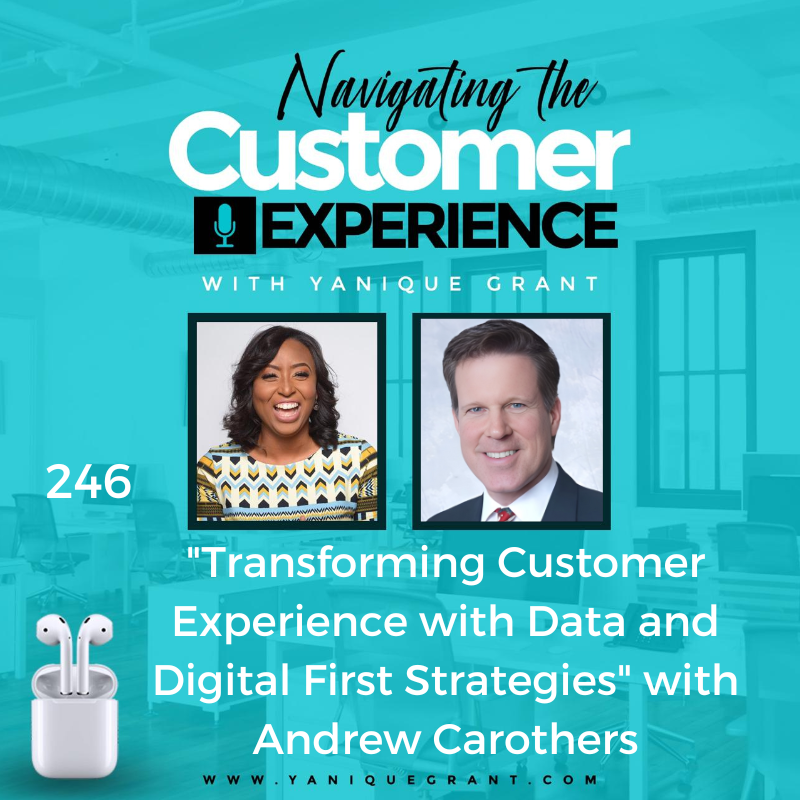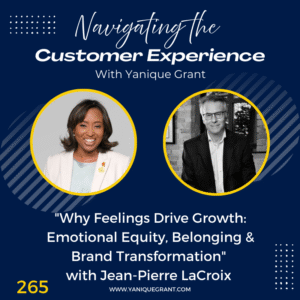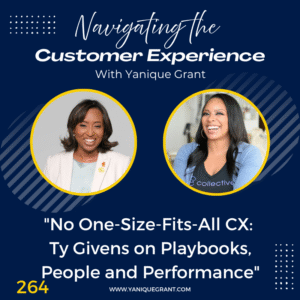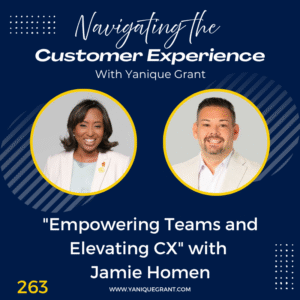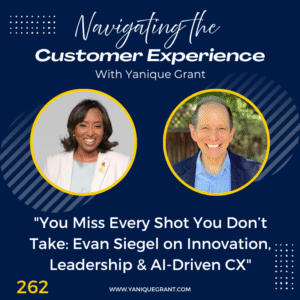Andrew Carothers is a CCXP, a Senior Customer Experience Leader helping companies build and scale organizations that increase customer adoption and retention, improve renewal rates and drive growth. A founding member of Cisco Systems CX function, Carothers has built extensive strategic and tactical CX knowledge, including digital CX, partner programs, voice of the customer, customer centric culture and journey mapping. Lots of exciting things.
A 12 time international customer experience award winner, he frequently writes and speaks on CX topics, and he’s co-authored The Publicity Handbook, a fortune book club selection. He currently serves as a member of the board of advisors for the University of San Francisco School of Management Strategic Artificial Intelligence Program.
Questions
- So, could you share with our listeners a little bit about your journey, how it is that you got from where you were to where you are today?
- What are some of the things that you believe customers are more paying attention to now?
- Do you think organization should invest in a knowledge base that’s not just content that it requires them to read, but maybe even has visual like maybe an MP4 file where you can watch a video on how to.
- If were to choose one word that’s going to drive the behaviors and competencies of your team, as it relates to CX for 2025, what would that be?
- Now, could you also share with our listeners, what’s the one online resource, tool, website or application that you absolutely cannot live without in your business?
- Could share with our listeners maybe one or two books that you’ve read, it could be a book that you read recently, or even one that you read a very long time ago, but it has had a great impact on you, whether personally or professionally.
- Could you share with our listeners, Andrew, what’s the one thing that’s going on in your life right now that you’re really excited about, either something you’re working on to develop yourself or your people.
- Where can listeners find you online?
- Now, before we wrap our episodes up, we always like to give our guests an opportunity to share with us. Do you have a quote or a saying that during times of adversity or challenge, you’ll tend to revert to this quote if for any reason you get derailed or you get off track, the quote kind of helps to get you back on track. Do you have one of those?
Highlights
Andrew’s Journey
Me: So, could you share with our listeners a little bit about your journey, how it is that you got from where you were to where you are today?
Andrew shared that he started his career in the field of public relations specifically, which is how he ended up writing The Publicity Handbook that Yanique mentioned before. And he worked at an agency, he worked in house. He started working at Autodesk technology company in the San Francisco Bay Area, which is where he lives, and that was his first foray into the technology world. And even worked for the Electric Vehicle Association of America before anybody heard of electric vehicles, this was years ago.
And then started to expand outside of just public relations into more corporate communications, investor relations, marketing communications, demand generation, so other marketing and communications fields. He worked for a few small companies. He had his own small boutique marketing agency, and then he joined Cisco Systems, starting off in the marketing field. They didn’t have a customer experience function at that time at Cisco, they sold hardware, they sold hardware that powered the internet, they were big boxes.
Their customers were typically in the IT department, they had large teams that were all trained in Cisco, they would sell them the gear and come back maybe 8 or 10 years later to say time to buy the next one. And they didn’t have a lot of choice, to be honest with you, because their whole teams were trained to use Cisco specifically.
So, at a point, they decided that they wanted as a company to move into more, change their business model to have more of a recurring revenue mix. So, that really changed things, and then that changed his career trajectory.
So, in a recurring revenue world, and then sort of the whole rise of the software as a service for SaaS industry, was part of the switch. Customers are not locked in for 8 to 10 years with a particular product, they can switch contracts or maybe a year long, maybe they’re 6 months long, maybe 1 month long, and so they have the opportunity to switch to a competitor much more quickly, and that then changes the responsibility from the customer to get value out of what they purchased to the company to make sure their customers are getting value out of what they’ve purchased, because now the customers are in control.
So, they started to build a customer experience function at Cisco, this is about 13 years ago, and that’s when he switched from marketing to customer experience.
And he thinks customer experience sort of the two parents typically for customer experience professionals or either marketing or customer support. And he came from the marketing side, so that’s why he got into it. And there were 100 of them at Cisco, the employee population at Cisco’s probably around 60,000 at the time, and only 100 of them were starting the CX function, and half of those people had come from, they started the function on a Monday, and half of those one other people were renewal contract sellers in the sales organization on the previous Friday. And then on Monday, they were doing the same thing.
So, there were really 50 of them that were creating a whole new function, a whole new way of doing business, a whole new way of interacting with their customers. And that’s what he started up with initially, and it’s continued to be both building the function with a particular emphasis on making digital connections with customers. So, that’s how he got to where he is today.
What Customers Are Paying Attention To
Me: Now, customer experience, as you mentioned before, it’s evolved. You’ve been in the space for a very long time now. What are some overarching areas that you find have changed. We’re human beings, and I don’t think we’ve changed that much over time, there have been definitely different things that have been introduced to us to stimulate us more. And of course, accessibility and convenience, and people just want to have things with less friction and just more ease. But if you could maybe just tap into maybe the date or even your own experiences as to why you believe, or what are some of the things that you believe customers are more paying attention to now?
Andrew shared that Yanique touched on one, so he won’t dive too deeply into it. But customers want and now expect a simple, consistent experience from the companies that they’re working with. And he thinks that’s for two reasons, he thinks that that expectation has been shaped by two things, really.
One is the rise of companies like Amazon and even Apple on more of a hardware and then a software perspective, where those companies have made the experience so easy, it’s so easy to go to amazon.com, find what you want, purchase it, everything about the search capability, the ratings capability that a buyer can look at, the actual purchasing process and then the return process, if need be is simple and fast and painless. And even then, the renewal, if you want to rebuy something that you’ve already bought, and maybe it’s groceries, or whatever it might be, it’s so simple to find the record of that previous purchase and just hit buy again.
And similarly, Apple has made their product, by and large, so easy to use, so easy to purchase, they’re expensive, but they’re so easy to use and so easy to walk into an Apple store or online and get training on how to use it. So, those are both examples from the business to consumer world.
The second thing that’s happened is that customers have learned to expect the same experience in their engagements with businesses in a B2B environment that they receive in a B2C environment. So, that’s a big shift, too. It’s sort of like, “Well, if Amazon can do it, why can’t you do it?”
So, which means that a company’s competitors are not just their traditional competitors in whatever they sell, it’s also from an experience perspective, it’s also every company, it’s Amazon, it’s, as he mentioned, Apple, it’s everybody, because customers have now come to expect so much from their daily lives, their consumer world, that they expect that now everywhere. So, those are two that’s a significant shift in as you described it.
The other thing that he thinks is really significant, and that’s risen, started before COVID, but was accelerated by COVID, is customers now want a digital first experience, all customers.
So, it used to be that companies thought of digital as a way to scale, as a way to scale to those customers that they couldn’t reach with their customer success teams that they had, or their customers managers, whatever might be, right? So, their most important customers got white glove concierge treatment.
And the next level of customers got, well, I’ve got one customer success manager working with 10 or 100 customers, whatever it might be, and everybody that I don’t really have the time for, they just get digital and not necessarily even a great digital experience, but at least they get something.
Now, he thinks partly because of the first trend that they talked about, he thinks every customer wants a digital first experience, and it’s not just him saying this, analysts say this. He was talking last week with the Director of Digital Customer Experience for Salesforce, he sees the same thing, their customers are telling this, everybody from the most loyal, from the highest value, from the largest customers to the smallest customers, want a digital first experience.
And that’s partly because they know that companies have so much data about those customers already that they expect something in return for that data. And it’s also partly because they want a faster, easier experience, and it’s a lot easier now to go to united.com to check airline flights and maybe purchase an airline ticket than it is to pick up the phone and call United, it’s just simpler.
He took a flight yesterday and tried to get on a standby list, ended up not getting on the standby list. All of these activities, none of it was done talking on the phone to an airline representative, it was all done digitally, it was all done poolside, off of his phone.
So, it’s so simple now…..his wife is a wealth manager, and she can initiate, she doesn’t do for clients, but for them, she sold a little bit of stock, she did it from her phone while they were sitting in the airplane waiting for the flight to take off.
It’s so easy to live in a digital world and to get things done anytime…..anywhere, so you don’t have to be sitting at your desk. As he said, he was sitting by the pool, his wife was sitting in an airplane waiting to take off. It’s so easy to engage digitally that customers want to engage digitally first.
Now, if they don’t get what they need, he’s not saying it’s a digital only experience, they want to be able to talk to a human if they need to find something that they can’t find on their own, or have a problem solved, whatever it might be. But to him, that’s a huge shift is the rise of customers wanting a digital first experience.
Me: When you spoke just now you sparked my interest a little bit when you said they will try to seek something on their own. Has it been your experience that the now type of customer, and this spans all generations, not even just if we were to just focus on one type of generation but all, would you say that they actively look to find the solution on their own before they reach out to the organization?
Andrew said absolutely, they have data that shows up to 80% of customers try to seek information on their own, self-service before they reach out to talk to a company. And he’ll point out that’s both, that’s not just post purchase, that’s also pre purchase, where customers are trying to figure out, not just will a product or a service provide the capabilities that I’m looking for, which is the first buying criteria listed by customers.
The second one is, what’s the quality of this, first is functionality, the second one is, but is it actually going to work?
And then the third one is not price anymore, it used to be, but now it’s what’s my experience going to be like if I buy this product, am I going to get what is promised and how difficult or easy is it going to be for me to get that?
Because if it works great, and the quality of the product is good, but it’s so awful to work with that company, I’d rather pay more.
So, they see that, and then what they’re seeing is customers therefore looking at, they’re looking at customer communities, they’re looking at whether to be the company’s community, or on Reddit or another social media platform. They’re doing that kind of research now to find out what are people saying about the company and the products that they’ve purchased, and then when they have purchased, they’re going to the same communities to get questions to their answers, or they’re going to the company’s website to get questions to their answers, or they’re going to maybe customer support, but they’re engaging digitally, first through a chatbot or through a knowledge base to try to find that answer.
It could be because they’re feeding their child at lunch, or they’re watching a soccer game, or it’s two in the morning and they can’t sleep, whatever it is. They find that the data shows, and they find all themselves that about 80% of customers go digitally first before trying to reach out to a company.
Organization Investing in a Knowledge Base
Me: That is brilliant. And so, it kind of supports my next question, do you think organization should invest in a knowledge base that’s not just content that it requires them to read, but maybe even has visual like maybe an MP4 file where you can watch a video on how to, especially if it’s something in relation to a physical product, or them having to navigate in terms of setting something up that they’ve purchased. Do you find that that type of investment and having that depository where customers can access it, not just for your internal team members to assist customers in troubleshooting, but also helping the customers that they can help themselves, is a good avenue for organizations to definitely take on?
Andrew stated that it’s a great question, and he thinks Yanique is absolutely correct, 100% because different customers, every customer wants to feel heard, and they want to feel understand, right….so, you see me, you know me, and therefore you can provide me for the solution that I’m looking for, now that solution could be “I just want a new toothbrush”, or it could be much more complex than that.
And if customers want to learn how do I set this up?
How do I use it?
How do I turn it on?
Or how do I get more value out of what I’ve purchased?
What are some really good tips, or tips or tricks, or I’m having trouble, how do I solve this?
Different customers learn different ways. So, some customers want a deep, thick user’s manual. Other people just give me a high level information, that’s all I need. Other people want more of a text based learning. Some want videos. Some want infographics. Kind of one of the nice things some want long video, some want short videos.
One of the things that addresses what you’re talking about for customers…..for companies that want to provide that who might think I don’t have the resources to be able to create a variety of content, and we haven’t even talked about translating it to different languages. But that’s very important for customers to be able to provide a customer information in their native language is not only likely depending on their language skill in whatever language, let’s say you might provide it in English in addition to French or whatever the language.
It tells customers, “I see you, I respect you. I’m going to provide this for you in your native language.” So, he thinks even language is important to Yanique’s point, that’s where he thinks companies can benefit from the rise of generative artificial intelligence, because there are a number of software programs out there, not all of them expensive, some of them even free, that companies can use to take their existing content and turn that into a variety of different versions of that same content.
Take a one hour video that maybe was created by a subject matter expert within the company, and turn that into a series of small videos, turn it into an FAQ, turn that into an infographic, translate that text into different languages and then use it as subtitles for that video so now you’ve got the video available in multiple languages, at least with closed captioning. So, he thinks it’s very important, and it’s easier than ever to do it, which then also means customers expect you to be able to do it for them.
One Word that Andrew Believes Would Drive His Team as it Relates to Customer Experience for 2025
Me: So, you’re currently at Cisco, right? Andrew, as I remember reading in your bio, could you tell us, as we’re wrapping up, we’re in the last quarter, about to start the last quarter of 2024. If were to choose one word that’s going to drive the behaviors and competencies of your team, as it relates to CX for 2025, what would that be?
Andrew stated that that’s a good question. If it’s one word, he’ll say “data”. It may be even more broadly digital, but to go down a little bit more deeply than just digital, data and being knowledgeable about data, so everything from being either a highly knowledgeable like a data scientist or data analyst, they’re using predictive AI to better understand their customers and what they’re talking about, what their needs are, so that they can then improve the experiences they’re providing their customers.
To collecting data, Cisco’s a large organization, a lot of silos within the company, a lot of different data sources coming in from different teams doing customer surveys, buying data, renewal data, data about how well customers are or are not adopting what they bought, where they get stuck. So, trying to collect all of that data so that they have a holistic view of their customers is a difficult task at a company as large as Cisco.
He would say it’s important even for smaller companies to take on this task as well, because there’s all these different pockets of data. But if it’s on different people’s laptops, it doesn’t help company provide the experience that a customer’s looking for. So, data will be an area of emphasis for them in 2025.
App, Website or Tool that Andrew Absolutely Can’t Live Without in His Business
When asked about online resource that he can’t live without in his business, Andrew stated that that is really hard question to answer with just one. So, he’s going to say ChatGPT or some other large language model, whether it’s Mistral or Claude, whatever it might be. And he’s going to say that because if he were stranded on a desert island and had internet access and needed just one tool, the ability to have that a large language model provides him with, the ability to learn about everything, to be able to communicate as they were talking about in different formats, and to be able to just analyze a company’s data, analyze a PDF or summarize an Excel spreadsheet for him, the amazing variety of things that a large language model could do to help him with his everyday tasks, as well as big picture strategic direction, he would choose that over any other tool.
ChatGPT, not an answer that he would have given 2 years ago, but he thinks things have advanced to the point today where that’s his answer.
Books that Have Had the Biggest Impact on Andrew
When asked about books that have had an impact, Andrew stated that he’ll share two books, one professional, one personal. The professional book is called Digital Hesitation: Why B2B Companies Aren’t Reaching Their Full Digital Transformation Potential, it came out about 4 or 5 years ago, by Thomas Lah, who is with the Technology Services Industry Association. And that book lays out in a very easy to read way. It lays out the imperative for digital customer experience. It lays out what customers are looking for, why a lot of the themes that he and Yanique have talked about today, and then how to address it, where to get started. So, Digital Hesitation by Thomas Lah is number one.
He’ll go back to when he was probably about 13 years old for a personal book, and it has stuck with him all the way through his life. And he’s read it probably 5 times now, and it had a profound influence on his, and that was Frankenstein by Mary Shelley, because it’s a gripping story for a little kid, little scary, but a gripping story. But then as he got older, as he reread it, and he started to learn and be taught about the different themes of the book, beyond just the plot lines, but the themes of different cultures clashing and the othering and his empathy grew for the so-called monster, and so at the fear of the villagers, he starts to understand more. There are so many societal themes in Frankenstein that resonate today, just as they did back in the 1800s when it was first written. So, Frankenstein is absolutely one of his favorite books.
So, you weren’t expecting that.
Me: I did not expect that. But that’s good. I like to hear different types of genres. I do believe that the different genres that we read can be non-professional, and a lot of times they spark creativity. And even though they might not necessarily be readily applicable to what we’re doing on a day-to-day basis, there are things in there that will cause us to think outside of the box, and those things can actually bring greater ideas and creativity to the day-to-day activities.
What Andrew is Really Excited About Now!
When asked about something that he’s excited about, Andrew stated that Yanique mentioned that he’s on the board of advisors for the University of San Francisco School of Management, Strategic Artificial Intelligence Program. So, that’s an area that he’s really excited about but AI overall, and particularly working with the University of San Francisco team. Because of the obvious role of artificial intelligence and so many ways that it can benefit individuals and companies and the risks involved, he thinks it’s important that we all be very mindful of artificial intelligence and the benefits and the risks, and the need to try to address the bias that can be inherent in it, and how to try to prevent ourselves from making the same mistake that we’ve made for years in other technologies, over and over and over again.
It’s an uphill battle, because there’s obviously a gold rush going on, and everybody wants to either be the first to use it or the second to make money out of it, whatever it might be. And so, issues of sort of social conscience tend to sort of get pushed to the wayside. But he thinks it’s important that we continue to push there. So, that’s the one area that, to him is the most significant and has the potential to have the greatest societal impact, not just business, but societal so that to him is the most exciting and important thing that he’s working on.
Where can listeners find Andrew online?
LinkedIn – Andrew Carothers
Quote or Saying that During Times of Adversity Andrew Uses
When asked about quote or saying that he tends to revert to, Andrew shared that there’s one quote, it’s almost a little bit of a cliche to mention it, because it’s a common quote, but often attributed to Shakespeare, “To thine own self, be true.”
And so, to him, that means, if he’s walking a difficult portion of his path, to stop and remind himself of who he is, what’s important to him, and his people, his family, his loved ones, his friends, that’s important to him.
So, it’s also a reminder for him to not try to walk the path alone, but to make sure that he’s connecting, it’s easy sometimes for people to kind of pull inward, he wants to make sure that he’s reminding himself to push outward and connect with people, and he’s a bit of an extrovert, but he wants to make sure that he’s reaching out to people. And he wants to make sure that he’s focusing in on and trusting himself to find the steps forward. So, that quote, “To thine own self, be true.” reminds him to do both of those things.
Me: Thank you so much, Andrew for coming on our podcast today and sharing with us all these great nuggets as it relates to customer experience, artificial intelligence. What customers are expecting, the shift that customers have made, the fact that customers are no longer comparing us with organizations that are similar to ours, but they’re comparing us to companies that aren’t even in the same industry as ours, and so we really have to raise the bar and look for opportunities to exceed their expectations. I think it was a great conversation and I really enjoyed chatting with you today.
Please connect with us on X @navigatingcx and also join our Private Facebook Community – Navigating the Customer Experience.
Links
- The Publicity Handbook by David R. Yale and Andrew Carothers
- Digital Hesitation: Why B2B Companies Aren’t Reaching Their Full Digital Transformation Potential by Thomas Lah
- Frankenstein by Mary Shelley
The ABC’s of a Fantastic Customer Experience
Grab the Freebie on Our Website – TOP 10 Online Business Resources for Small Business Owners
Do you want to pivot your online customer experience and build loyalty – get a copy of “The ABC’s of a Fantastic Customer Experience.” The ABC’s of a Fantastic Customer Experience provides 26 easy to follow steps and techniques that helps your business to achieve success and build brand loyalty.
This Guide to Limitless, Happy and Loyal Customers will help you to strengthen your service delivery, enhance your knowledge and appreciation of the customer experience and provide tips and practical strategies that you can start implementing immediately!
This book will develop your customer service skills and sharpen your attention to detail when serving others.
Master your customer experience and develop those knock your socks off techniques that will lead to lifetime customers. Your customers will only want to work with your business and it will be your brand differentiator. It will lead to recruiters to seek you out by providing practical examples on how to deliver a winning customer service experience!

